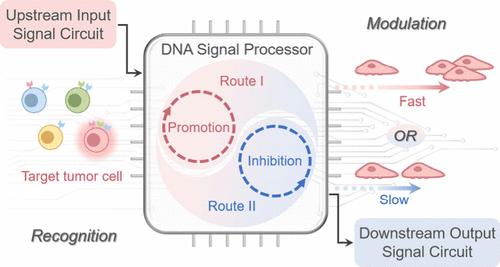当前位置:
X-MOL 学术
›
Nano Lett.
›
论文详情
Our official English website, www.x-mol.net, welcomes your
feedback! (Note: you will need to create a separate account there.)
Tumor Cell-Specific Signal Processing Platform Controlled by ATP for Non-invasive Modulation of Cellular Behavior
Nano Letters ( IF 9.6 ) Pub Date : 2024-11-11 , DOI: 10.1021/acs.nanolett.4c04445 Guofang Zhang, Shuzhen Yue, Hongyan Geng, Xin-yan Wang, Tian Tian, Zhumei Cui, Sai Bi
Nano Letters ( IF 9.6 ) Pub Date : 2024-11-11 , DOI: 10.1021/acs.nanolett.4c04445 Guofang Zhang, Shuzhen Yue, Hongyan Geng, Xin-yan Wang, Tian Tian, Zhumei Cui, Sai Bi

|
Regulating the spatial distribution of membrane receptors can artificially reprogram cellular behaviors, which play a critical biological role in various physiological and pathological processes. Herein, we construct a tumor cell-specific signal processing platform (TCS-SPP) for controlled promotion/inhibition of cellular-mesenchymal epithelial transition factor (c-Met) receptor dimerization to noninvasively modulate cellular behaviors. Upon the dual-aptamer recognition in the upstream input signal circuit (UISC) to discriminate target cancer cells, the membrane-anchored DNA signal processor (DSP) is activated for signal amplification via rolling circle amplification (RCA) followed by the working of an ATP molecular switch for signal conversion, achieving receptor modulation in the downstream output signal circuit (DOSC). Benefiting from the rigid structure of DSP, the protective effect, and spatial confinement effect of RCA products, this TCS-SPP has demonstrated good performance in accurately modulating cellular behavior such as cell migration, invasion, and proliferation, showing great potential for targeted cancer therapy and biomedical engineering applications.
中文翻译:

由 ATP 控制的肿瘤细胞特异性信号处理平台,用于细胞行为的无创调节
调节膜受体的空间分布可以人工重编程细胞行为,这些行为在各种生理和病理过程中起着关键的生物学作用。在此,我们构建了一个肿瘤细胞特异性信号处理平台 (TCS-SPP),用于控制促进/抑制细胞间充质上皮转化因子 (c-Met) 受体二聚化,以无创调节细胞行为。在上游输入信号电路 (UISC) 中识别双适配体以区分目标癌细胞后,膜锚定 DNA 信号处理器 (DSP) 被激活,通过滚环放大 (RCA) 进行信号放大,然后 ATP 分子开关工作以进行信号转换,在下游输出信号电路 (DOSC) 中实现受体调制。得益于 DSP 的刚性结构、RCA 产品的保护作用和空间限制作用,该 TCS-SPP 在准确调节细胞迁移、侵袭和增殖等细胞行为方面表现出良好的性能,显示出靶向癌症治疗和生物医学工程应用的巨大潜力。
更新日期:2024-11-11
中文翻译:

由 ATP 控制的肿瘤细胞特异性信号处理平台,用于细胞行为的无创调节
调节膜受体的空间分布可以人工重编程细胞行为,这些行为在各种生理和病理过程中起着关键的生物学作用。在此,我们构建了一个肿瘤细胞特异性信号处理平台 (TCS-SPP),用于控制促进/抑制细胞间充质上皮转化因子 (c-Met) 受体二聚化,以无创调节细胞行为。在上游输入信号电路 (UISC) 中识别双适配体以区分目标癌细胞后,膜锚定 DNA 信号处理器 (DSP) 被激活,通过滚环放大 (RCA) 进行信号放大,然后 ATP 分子开关工作以进行信号转换,在下游输出信号电路 (DOSC) 中实现受体调制。得益于 DSP 的刚性结构、RCA 产品的保护作用和空间限制作用,该 TCS-SPP 在准确调节细胞迁移、侵袭和增殖等细胞行为方面表现出良好的性能,显示出靶向癌症治疗和生物医学工程应用的巨大潜力。


















































 京公网安备 11010802027423号
京公网安备 11010802027423号